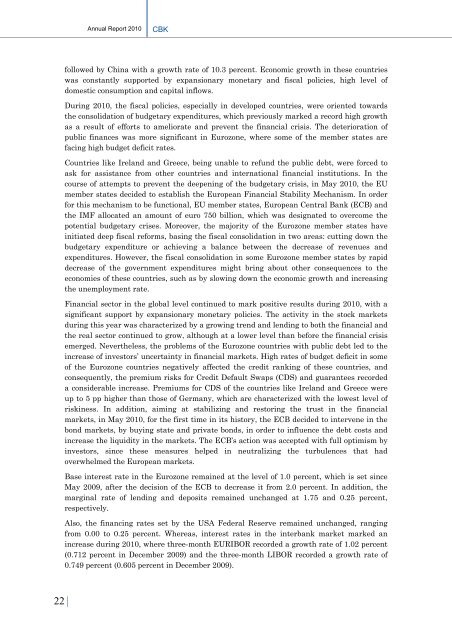Annual Report 2010 03 August 2011 - Banka Qendrore e ...
Annual Report 2010 03 August 2011 - Banka Qendrore e ...
Annual Report 2010 03 August 2011 - Banka Qendrore e ...
You also want an ePaper? Increase the reach of your titles
YUMPU automatically turns print PDFs into web optimized ePapers that Google loves.
<strong>Annual</strong> <strong>Report</strong> <strong>2010</strong><br />
CBK<br />
followed by China with a growth rate of 10.3 percent. Economic growth in these countries<br />
was constantly supported by expansionary monetary and fiscal policies, high level of<br />
domestic consumption and capital inflows.<br />
During <strong>2010</strong>, the fiscal policies, especially in developed countries, were oriented towards<br />
the consolidation of budgetary expenditures, which previously marked a record high growth<br />
as a result of efforts to ameliorate and prevent the financial crisis. The deterioration of<br />
public finances was more significant in Eurozone, where some of the member states are<br />
facing high budget deficit rates.<br />
Countries like Ireland and Greece, being unable to refund the public debt, were forced to<br />
ask for assistance from other countries and international financial institutions. In the<br />
course of attempts to prevent the deepening of the budgetary crisis, in May <strong>2010</strong>, the EU<br />
member states decided to establish the European Financial Stability Mechanism. In order<br />
for this mechanism to be functional, EU member states, European Central Bank (ECB) and<br />
the IMF allocated an amount of euro 750 billion, which was designated to overcome the<br />
potential budgetary crises. Moreover, the majority of the Eurozone member states have<br />
initiated deep fiscal reforms, basing the fiscal consolidation in two areas: cutting down the<br />
budgetary expenditure or achieving a balance between the decrease of revenues and<br />
expenditures. However, the fiscal consolidation in some Eurozone member states by rapid<br />
decrease of the government expenditures might bring about other consequences to the<br />
economies of these countries, such as by slowing down the economic growth and increasing<br />
the unemployment rate.<br />
Financial sector in the global level continued to mark positive results during <strong>2010</strong>, with a<br />
significant support by expansionary monetary policies. The activity in the stock markets<br />
during this year was characterized by a growing trend and lending to both the financial and<br />
the real sector continued to grow, although at a lower level than before the financial crisis<br />
emerged. Nevertheless, the problems of the Eurozone countries with public debt led to the<br />
increase of investors’ uncertainty in financial markets. High rates of budget deficit in some<br />
of the Eurozone countries negatively affected the credit ranking of these countries, and<br />
consequently, the premium risks for Credit Default Swaps (CDS) and guarantees recorded<br />
a considerable increase. Premiums for CDS of the countries like Ireland and Greece were<br />
up to 5 pp higher than those of Germany, which are characterized with the lowest level of<br />
riskiness. In addition, aiming at stabilizing and restoring the trust in the financial<br />
markets, in May <strong>2010</strong>, for the first time in its history, the ECB decided to intervene in the<br />
bond markets, by buying state and private bonds, in order to influence the debt costs and<br />
increase the liquidity in the markets. The ECB’s action was accepted with full optimism by<br />
investors, since these measures helped in neutralizing the turbulences that had<br />
overwhelmed the European markets.<br />
Base interest rate in the Eurozone remained at the level of 1.0 percent, which is set since<br />
May 2009, after the decision of the ECB to decrease it from 2.0 percent. In addition, the<br />
marginal rate of lending and deposits remained unchanged at 1.75 and 0.25 percent,<br />
respectively.<br />
Also, the financing rates set by the USA Federal Reserve remained unchanged, ranging<br />
from 0.00 to 0.25 percent. Whereas, interest rates in the interbank market marked an<br />
increase during <strong>2010</strong>, where three-month EURIBOR recorded a growth rate of 1.02 percent<br />
(0.712 percent in December 2009) and the three-month LIBOR recorded a growth rate of<br />
0.749 percent (0.605 percent in December 2009).<br />
22 |

















